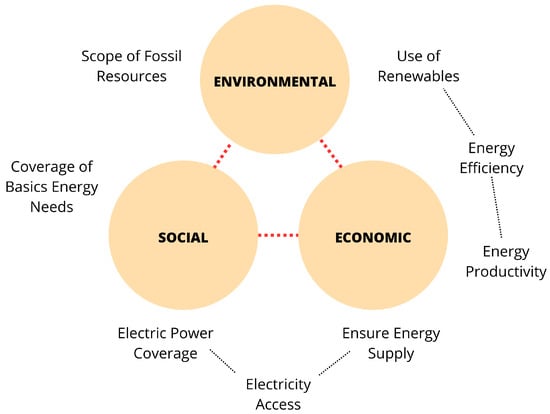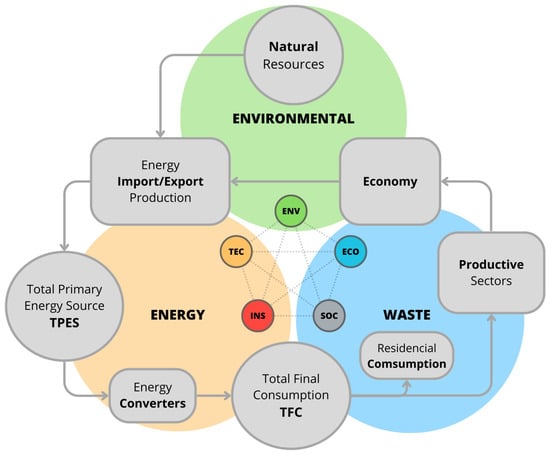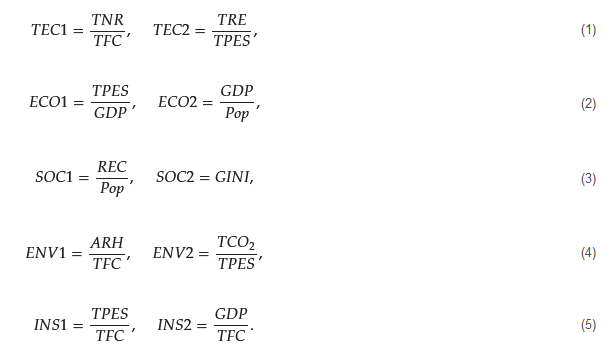
| Version | Summary | Created by | Modification | Content Size | Created at | Operation |
|---|---|---|---|---|---|---|
| 1 | Rafael Ninno Muniz | -- | 3031 | 2023-10-01 16:00:37 | | | |
| 2 | Lindsay Dong | Meta information modification | 3031 | 2023-10-06 14:47:01 | | |
Video Upload Options
The concept of sustainability, with a focus on energy, has emerged as a central tenet in addressing the mounting global challenges of environmental degradation and resource depletion. Indicators of sustainability focusing on energy are crucial tools used to assess and monitor progress toward achieving a more sustainable energy system. These indicators provide valuable insights into the environmental, social, and economic dimensions of energy practices and their long-term impacts. By analyzing and understanding these indicators, policymakers, businesses, and communities can make informed decisions, formulate effective policies, and steer their efforts toward a more sustainable energy future. These indicators serve as navigational guides, steering the world toward energy practices that support both present needs and the well-being of future generations.
1. Introduction

2. Technology and Efficiency Improvement
3. Sustainable Development Index and Indicators

Sustainability Indicators
| Indicator | Significance | Purpose | References |
|---|---|---|---|
| TEC1 | Dependence on fossil fuels | Measures the rate of consumption of sources in relation to total final consumption. | [48]. |
| TEC2 | Renewable generation | Measures the rate of renewable generation to total primary generation. | [49][50]. |
| ECO1 | Energy intensity | Measures the use of primary energy needed to generate one unit of GDP. | [51][52]. |
| ECO2 | Economic productivity | Measures productivity per inhabitant. | [48][52]. |
| SOC1 | Social use of energy | Measures residential energy consumption per inhabitant. | [51][53][54]. |
| SOC2 | Social inequality | Considerated GINI Income Inequality Index. | [51][55][56]. |
| ENV1 | Energy deforestation | Measures deforestation due to energy generation generation. | [48][51]. |
| ENV2 | Carbon intensity | Measures carbon emissions from generation and waste disposal. | [51]. |
| INS1 | Energy security | Measures the rate of dependence on the import/export of energy. | [49]. |
| INS2 | Energy productivity | Measures the rate of energy consumption to produce one unit of GDP. | [48]. |
These indicators are used to evaluate the level of sustainability for the considered dimensions. These indicators are calculated as follows:

To apply the indicators, it is necessary to normalize them to have a standard parameter for comparisons. There are some indicators that have used by the same authors, which is because there is a relationship between indicators. In Table 2, a matrix of these relationships is presented.
| Indicator | TEC1 | TEC2 | ECO1 | ECO2 | SOC1 | SOC2 | ENV1 | ENV2 | INS1 | INS2 |
|---|---|---|---|---|---|---|---|---|---|---|
| TEC1 | x | x | x | x | x | x | ||||
| TEC2 | x | x | x | x | ||||||
| ECO1 | x | x | x | x | x | x | ||||
| ECO2 | x | x | x | x | x | |||||
| SOC1 | x | x | x | x | x | x | x | |||
| SOC2 | x | x | x | x | ||||||
| ENV1 | x | x | x | x | x | x | ||||
| ENV2 | x | x | x | x | x | |||||
| INS1 | x | x | x | x | x | x | x | |||
| INS2 | x | x | x | x | x | x |
Any index of a regional, national, or international nature requires interpretation prior to its application in order to establish a reliable characterization, verifying that additional indicators can be included and that it meets the prerequisites designated by the targets previously established in governance plans. Subsidies and guarantees are critical factors within developing countries and can be considered as additional indicators to measure their importance quantitatively and qualitatively [57].
Besides all indicators having a relation to the indicators of the same dimension, some of them have an additional relationship with other dimensions, which highlights the statement previously discussed in the introduction section regarding the interconnection between the sustainability dimensions.
4. Conclusions
The sustainability concept focusing on energy is a critical and multifaceted approach that recognizes the importance of preserving and efficiently utilizing our planet’s finite resources.
By shifting toward renewable and clean energy sources, such as solar, wind, hydro, geothermal, and bioenergy, we can significantly reduce greenhouse gas emissions and curb the detrimental impact of fossil fuels on our environment. Embracing sustainable energy solutions not only mitigates the effects of climate change but also fosters energy independence and resilience, as these sources are naturally replenished and less susceptible to geopolitical tensions.
Integrating sustainable energy practices into our daily lives and industries promotes economic growth and job creation. The transition to clean energy technologies and infrastructures opens up new avenues for innovation and investment, stimulating green industries and green-collar employment opportunities. Energy efficiency used as a daily practice, for instance, reducing the consumption of air conditioning, has an impact on the preservation of natural resources and a reduction in the emissions of pollutants.
References
- Andriuškevičius, K.; Štreimikienė, D.; Alebaitė, I. Convergence between Indicators for Measuring Sustainable Development and M&A Performance in the Energy Sector. Sustainability 2022, 14, 10360.
- Lindsey, T.C. Sustainable principles: Common values for achieving sustainability. J. Clean. Prod. 2011, 19, 561–565.
- Shah, S.; Zhou, P.; Walasai, G.; Mohsin, M. Energy security and environmental sustainability index of South Asian countries: A composite index approach. Ecol. Indic. 2019, 106, 105507.
- Usubiaga-Liano, A.; Ekins, P. Monitoring the environmental sustainability of countries through the strong environmental sustainability index. Ecol. Indic. 2021, 132, 108281.
- Rasoolimanesh, S.M.; Ramakrishna, S.; Hall, C.M.; Esfandiar, K.; Seyfi, S. A systematic scoping review of sustainable tourism indicators in relation to the sustainable development goals. J. Sustain. Tour. 2020, 31, 1497–1517.
- Fischer, D.; Brettel, M.; Mauer, R. The three dimensions of sustainability: A delicate balancing act for entrepreneurs made more complex by stakeholder expectations. J. Bus. Ethics 2020, 163, 87–106.
- Philippidis, G.; Sartori, M.; Ferrari, E.; M’Barek, R. Waste not, want not: A bio-economic impact assessment of household food waste reductions in the EU. Resour. Conserv. Recycl. 2019, 146, 514–522.
- Schneider, F.; Kläy, A.; Zimmermann, A.B.; Buser, T.; Ingalls, M.; Messerli, P. How can science support the 2030 Agenda for Sustainable Development? Four tasks to tackle the normative dimension of sustainability. Sustain. Sci. 2019, 14, 1593–1604.
- Kristensen, H.S.; Mosgaard, M.A. A review of micro level indicators for a circular economy–moving away from the three dimensions of sustainability? J. Clean. Prod. 2020, 243, 118531.
- Terra dos Santos, L.C.; Giannetti, B.F.; Agostinho, F.; Liu, G.; Almeida, C.M. A multi-criteria approach to assess interconnections among the environmental, economic, and social dimensions of circular economy. J. Environ. Manag. 2023, 342, 118317.
- Janker, J.; Mann, S. Understanding the social dimension of sustainability in agriculture: A critical review of sustainability assessment tools. Environ. Dev. Sustain. 2020, 22, 1671–1691.
- Hutchins, M.J.; Richter, J.S.; Henry, M.L.; Sutherland, J.W. Development of indicators for the social dimension of sustainability in a U.S. business context. J. Clean. Prod. 2019, 212, 687–697.
- Stanković, J.J.; Marjanović, I.; Papathanasiou, J.; Drezgić, S. Social, economic and environmental sustainability of port regions: Mcdm approach in composite index creation. J. Mar. Sci. Eng. 2021, 9, 74.
- Sánchez-Flores, R.B.; Cruz-Sotelo, S.E.; Ojeda-Benitez, S.; Ramírez-Barreto, M.E. Sustainable supply chain management—A literature review on emerging economies. Sustainability 2020, 12, 6972.
- Chen, C.; Chaudhary, A.; Mathys, A. Dietary change scenarios and implications for environmental, nutrition, human health and economic dimensions of food sustainability. Nutrients 2019, 11, 856.
- Corso, M.P.; Stefenon, S.F.; Singh, G.; Matsuo, M.V.; Perez, F.L.; Leithardt, V.R.Q. Evaluation of visible contamination on power grid insulators using convolutional neural networks. Electr. Eng. 2023, 1–14.
- Souza, B.J.; Stefenon, S.F.; Singh, G.; Freire, R.Z. Hybrid-YOLO for classification of insulators defects in transmission lines based on UAV. Int. J. Electr. Power Energy Syst. 2023, 148, 108982.
- Stefenon, S.F.; Seman, L.O.; Aquino, L.S.; dos Santos Coelho, L. Wavelet-Seq2Seq-LSTM with attention for time series forecasting of level of dams in hydroelectric power plants. Energy 2023, 274, 127350.
- Kartal, M.T.; Samour, A.; Adebayo, T.S.; Depren, S.K. Do nuclear energy and renewable energy surge environmental quality in the United States? New insights from novel bootstrap Fourier Granger causality in quantiles approach. Prog. Nucl. Energy 2023, 155, 104509.
- Stefenon, S.F.; Seman, L.O.; Mariani, V.C.; Coelho, L.d.S. Aggregating Prophet and Seasonal Trend Decomposition for Time Series Forecasting of Italian Electricity Spot Prices. Energies 2023, 16, 1371.
- Shen, Y.; Zhou, J.; Zhang, J.; Yi, F.; Wang, G.; Pan, C.; Guo, W.; Shu, X. Research on Energy Management of Hydrogen Fuel Cell Bus Based on Deep Reinforcement Learning Considering Velocity Control. Sustainability 2023, 15, 12488.
- Seman, L.O.; Stefenon, S.F.; Mariani, V.C.; dos Santos Coelho, L. Ensemble learning methods using the Hodrick–Prescott filter for fault forecasting in insulators of the electrical power grids. Int. J. Electr. Power Energy Syst. 2023, 152, 109269.
- Borré, A.; Seman, L.O.; Camponogara, E.; Stefenon, S.F.; Mariani, V.C.; Coelho, L.S. Machine fault detection using a hybrid CNN-LSTM attention-based model. Sensors 2023, 23, 4512.
- Vieira, J.C.; Sartori, A.; Stefenon, S.F.; Perez, F.L.; de Jesus, G.S.; Leithardt, V.R.Q. Low-Cost CNN for automatic violence recognition on embedded system. IEEE Access 2022, 10, 25190–25202.
- dos Santos, G.H.; Seman, L.O.; Bezerra, E.A.; Leithardt, V.R.Q.; Mendes, A.S.; Stefenon, S.F. Static attitude determination using convolutional neural networks. Sensors 2021, 21, 6419.
- Singh, G.; Stefenon, S.F.; Yow, K.C. Interpretable visual transmission lines inspections using pseudo-prototypical part network. Mach. Vis. Appl. 2023, 34, 41.
- Corso, M.P.; Perez, F.L.; Stefenon, S.F.; Yow, K.C.; García Ovejero, R.; Leithardt, V.R.Q. Classification of contaminated insulators using k-nearest neighbors based on computer vision. Computers 2021, 10, 112.
- Glasenapp, L.A.; Hoppe, A.F.; Wisintainer, M.A.; Sartori, A.; Stefenon, S.F. OCR applied for identification of vehicles with irregular documentation using IoT. Electronics 2023, 12, 1083.
- Khishtandar, S.; Zandieh, M.; Dorri, B. A multi criteria decision making framework for sustainability assessment of bioenergy production technologies with hesitant fuzzy linguistic term sets: The case of Iran. Renew. Sustain. Energy Rev. 2017, 77, 1130–1145.
- Kaya, I.; Colak, M.; Terzi, F. A comprehensive review of fuzzy multi criteria decision making methodologies for energy policy making. Energy Strategy Rev. 2019, 24, 207–228.
- Solangi, Y.A.; Tan, Q.; Mirjat, N.H.; Ali, S. Evaluating the strategies for sustainable energy planning in Pakistan: An integrated SWOT-AHP and Fuzzy-TOPSIS approach. J. Clean. Prod. 2019, 236, 117655.
- Hezam, I.M.; Mishra, A.R.; Rani, P.; Saha, A.; Smarandache, F.; Pamucar, D. An integrated decision support framework using single-valued neutrosophic-MASWIP-COPRAS for sustainability assessment of bioenergy production technologies. Expert Syst. Appl. 2023, 211, 118674.
- Sahabuddin, M.; Khan, I. Multi-criteria decision analysis methods for energy sector’s sustainability assessment: Robustness analysis through criteria weight change. Sustain. Energy Technol. Assess. 2021, 47, 101380.
- Ervural, B.C.; Zaim, S.; Demirel, O.F.; Aydin, Z.; Delen, D. An ANP and fuzzy TOPSIS-based SWOT analysis for Turkey’s energy planning. Renew. Sustain. Energy Rev. 2018, 82, 1538–1550.
- Neofytou, H.; Nikas, A.; Doukas, H. Sustainable energy transition readiness: A multicriteria assessment index. Renew. Sustain. Energy Rev. 2020, 131, 109988.
- Zhao, D.; Cai, J.; Shen, L.; Elshkaki, A.; Liu, J.; Varis, O. Delivery of energy sustainability: Applications of the “STAR” protocol to the Sustainable Development Goal 7 index and its interaction analysis. J. Clean. Prod. 2023, 389, 135884.
- Padilla-Rivera, A.; Paredes, M.G.; Güereca, L.P. A systematic review of the sustainability assessment of bioenergy: The case of gaseous biofuels. Biomass Bioenergy 2019, 125, 79–94.
- Elavarasan, R.M.; Afridhis, S.; Vijayaraghavan, R.R.; Subramaniam, U.; Nurunnabi, M. SWOT analysis: A framework for comprehensive evaluation of drivers and barriers for renewable energy development in significant countries. Energy Rep. 2020, 6, 1838–1864.
- Yin, C.; Zhao, W.; Ye, J.; Muroki, M.; Pereira, P. Ecosystem carbon sequestration service supports the Sustainable Development Goals progress. J. Environ. Manag. 2023, 330, 117155.
- Luo, C.; Ju, Y.; Gonzalez, E.D.S.; Dong, P.; Wang, A. The waste-to-energy incineration plant site selection based on hesitant fuzzy linguistic Best-Worst method ANP and double parameters TOPSIS approach: A case study in China. Energy 2020, 211, 118564.
- Altintas, K.; Vayvay, O.; Apak, S.; Cobanoglu, E. An extended GRA method integrated with fuzzy AHP to construct a multidimensional index for ranking overall energy sustainability performances. Sustainability 2020, 12, 1602.
- Bas, E. The integrated framework for analysis of electricity supply chain using an integrated SWOT-fuzzy TOPSIS methodology combined with AHP: The case of Turkey. Int. J. Electr. Power Energy Syst. 2013, 44, 897–907.
- Davoodi, M.; Jafari Kaleybar, H.; Brenna, M.; Zaninelli, D. Energy Management Systems for Smart Electric Railway Networks: A Methodological Review. Sustainability 2023, 15, 12204.
- Mohsin, M.; Rasheed, A.; Sun, H.; Zhang, J.; Iram, R.; Iqbal, N.; Abbas, Q. Developing low carbon economies: An aggregated composite index based on carbon emissions. Sustain. Energy Technol. Assess. 2019, 35, 365–374.
- Mohsin, M.; Taghizadeh-Hesary, F.; Panthamit, N.; Anwar, S.; Abbas, Q.; Vo, X.V. Developing low carbon finance index: Evidence from developed and developing economies. Financ. Res. Lett. 2021, 43, 101520.
- Wang, J.; Chen, H.; Cao, Y.; Wang, C.; Li, J. An integrated optimization framework for regional energy planning with a sustainability assessment model. Sustain. Prod. Consum. 2023, 36, 526–539.
- Ponomarenko, T.; Reshneva, E.; Mosquera Urbano, A.P. Assessment of energy sustainability issues in the andean community: Additional indicators and their interpretation. Energies 2022, 15, 1077.
- Grigoroudis, E.; Kouikoglou, V.S.; Phillis, Y.A.; Kanellos, F.D. Energy sustainability: A definition and assessment model. Oper. Res. 2021, 21, 1845–1885.
- García-Álvarez, M.T.; Moreno, B.; Soares, I. Analyzing the sustainable energy development in the EU-15 by an aggregated synthetic index. Ecol. Indic. 2016, 60, 996–1007.
- Sovacool, B.K. The methodological challenges of creating a comprehensive energy security index. Energy Policy 2012, 48, 835–840.
- Iddrisu, I.; Bhattacharyya, S.C. Sustainable Energy Development Index: A multi-dimensional indicator for measuring sustainable energy development. Renew. Sustain. Energy Rev. 2015, 50, 513–530.
- IBGE. Territorial Organization (Structure): Legal Amazon. Available online: https://geoftp.ibge.gov.br/organizacao_do_territorio/estrutura_territorial/amazonia_legal/2022/Mapa_da_Amazonia_Legal_2022_sem_sedes.pdf (accessed on 31 August 2023).
- Brown, M.A.; Sovacool, B.K. Developing an’energy sustainability index’to evaluate energy policy. Interdiscip. Sci. Rev. 2007, 32, 335–349.
- Liu, G. Development of a general sustainability indicator for renewable energy systems: A review. Renew. Sustain. Energy Rev. 2014, 31, 611–621.
- German Agency for Technical Cooperation; NU. CEPAL; OLADE. Energy and Sustainable Development in Latin America and the Caribbean: Approaches to Energy Policy. 1997. Available online: https://repositorio.cepal.org/items/8ace52db-c1e0-4b71-b7a9-7ddbb98b69d4 (accessed on 31 August 2023).
- Vera, I.A.; Langlois, L.M.; Rogner, H.H.; Jalal, A.; Toth, F.L. Indicators for sustainable energy development: An initiative by the International Atomic Energy Agency. Nat. Resour. Forum 2005, 29, 274–283.
- Shanmugam, K.; Gadhamshetty, V.; Tysklind, M.; Bhattacharyya, D.; Upadhyayula, V.K. A sustainable performance assessment framework for circular management of municipal wastewater treatment plants. J. Clean. Prod. 2022, 339, 130657.
- Bompard, E.; Ciocia, A.; Grosso, D.; Huang, T.; Spertino, F.; Jafari, M.; Botterud, A. Assessing the role of fluctuating renewables in energy transition: Methodologies and tools. Appl. Energy 2022, 314, 118968.
- Tiwari, A.K.; Abakah, E.J.A.; Shao, X.; Le, T.L.; Gyamfi, M.N. Financial technology stocks, green financial assets, and energy markets: A quantile causality and dependence analysis. Energy Econ. 2023, 118, 106498.
- Wang, J.; Dong, X.; Dong, K. Does renewable energy technological innovation matter for green total factor productivity? Empirical evidence from Chinese provinces. Sustain. Energy Technol. Assess. 2023, 55, 102966.




